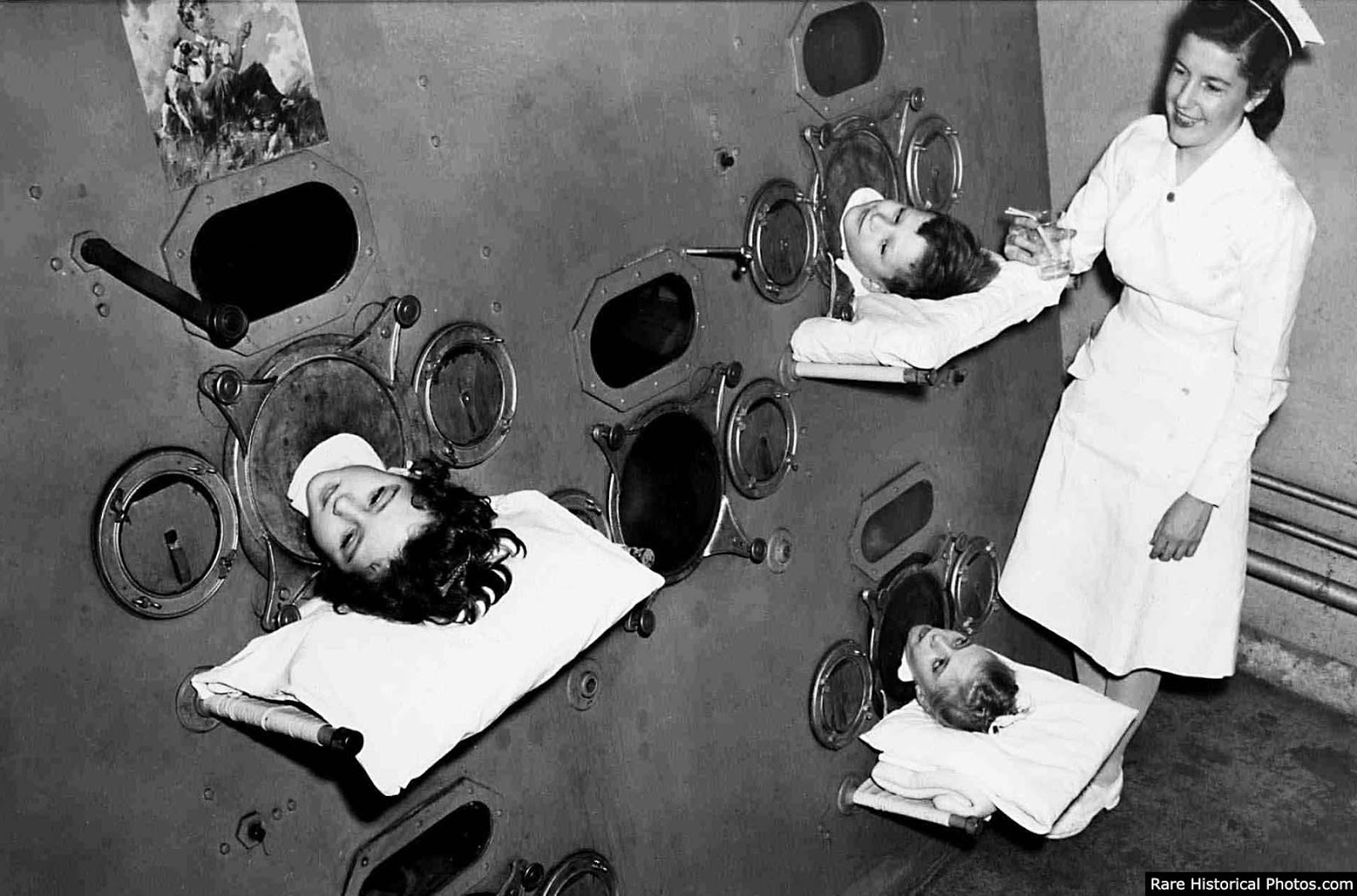
1950s multi-person ventilator.
An iron lung or as it is called officially a negative pressure ventilator is a form of medical ventilator that enables a person to breathe when normal muscle control has been lost or the work of breathing exceeds the person’s ability.
It creates lower pressure around the thorax and this expands the rib cage and draws air into the lungs.
Polio makes the body lose muscle control, including the diaphragm. Since the diaphragm uses pressure to regulate the oxygen intake (by expanding and decreasing pressure in the lungs, causing air to flow in), this machine regulates the pressure increasing it and decreasing artificially in order to make breathing possible.
Paulo Henrique Machado, a Brazilian man, who has been in hospital for 45 years after he was struck down by polio when he was a child:
Forced to live in what was called a ‘torpedo’ – effectively a body-encasing iron lung – during his early years, he was forced to create his own ‘universe’ inside the confines of his hospital prison.
His earliest memories are of ‘exploring’ the corridors of each ward in his wheelchair, wandering into the rooms of other children, his only toy being his imagination.
But, with an average life expectancy of just ten years, Paulo and Eliana (his hospital friend) watched all their friends die, one by one. Doctors never understood why Paulo and Eliana outlived the others, but they say the experience, while sad, has brought them closer together.
‘It was difficult,’ says Machado. ‘Each loss was like a dismembering, you know, physical… like mutilation. Now, there’s just two of us left – me and Eliana.’ The risk of infection is high for Paulo and Eliana, so they rarely travel outside of the hospital.
Another story of surviving the iron lung, the story of Mary Virginia:
Mary Virginia was born in 1930, to a well-off family. Her childhood was happy enough, until the summer of 1937. Mary Virginia went to the neighborhood swimming pool and had a lovely time.
The next day, right before bed, she felt a little fuzzy. Her mom touched her forehead: the child was a little feverish, so her mother called the doctor.
Within hours, Mary Virginia could not control her lower body; within two days she was in an iron lung, in a hospital. She told her granddaughter that she shared a communal iron lung with four other children at a time (an “Emerson”, she called it).
There were dozens of children with polio in the hospital. The turnover was high. Within six months, she and only two others were the only ones left from the original group she saw.
In the communal iron lung turn over was fast for a grimmer reason: children died. Mary Virginia stopped counting her lost companions when she reached 24: she didn’t know how to count any higher than that.
She had an aversion to the number 24 since then: it reminded her of the children she saw die. For 3-4 years Mary Virginia lived in the iron lung.
The nurses who treated her would move her arms and legs to maintain some kind of muscle. Her parents would visit her throughout the years she spent at the hospital, but although they were financially well off, the price and lengths of the train trip meant their visits were limited.
Mary Virginia’s mother always felt guilty about that. Still, they saw Mary Virginia more often than most parents saw their kids.
Heather, Mary Virginia’s granddaughter, remembers that her grandmother told her that her own mother brought “knitted hats, and little trinkets for the kids. And books, books were very important”.
How the patients would use the bathroom?
The front part of the iron lung where the patient’s head comes out attaches to the “tin can” and can be unbuckled and pulled out, thus exposing the patient’s body on the bed.
He is lifted up by a nurse and a bedpan is slid under him. The iron lung is then closed where it resumes breathing. The procedure is repeated to remove the pan.
About Polio
Polio is a crippling and sometimes fatal virus that has been all but wiped out in the developed world. A highly infectious disease, polio attacks the nervous system and can lead to paralysis, disability, and even death.
The symptoms – pain and weakness, fatigue, and muscle loss – can strike any time from 15 to 50 years after the initial disease.
One of the major breakthroughs was the invention of the iron lung, the body-encasing machine that fills lungs with air by making the chest rise.
Before its invention, children with polio died frequently. Thanks to a vaccine program in the 1960s, Polio has been eradicated, though it remains a problem in Nigeria, Afghanistan, and Pakistan.